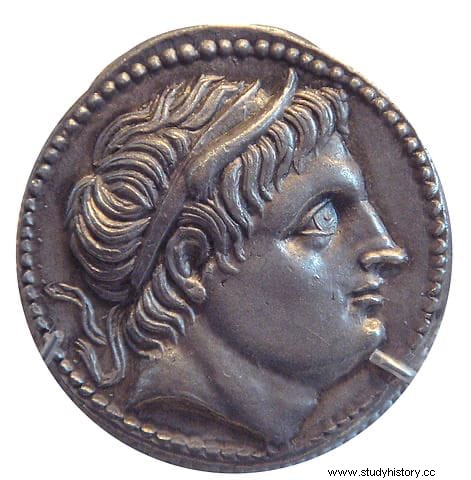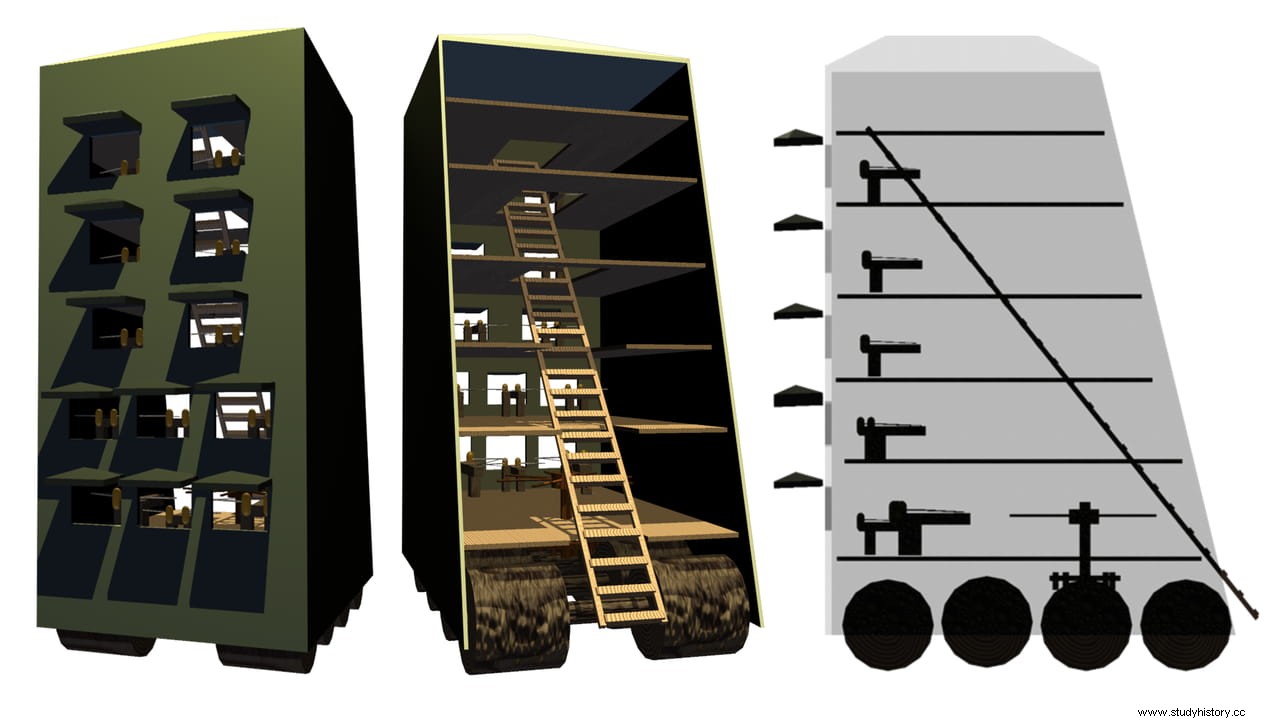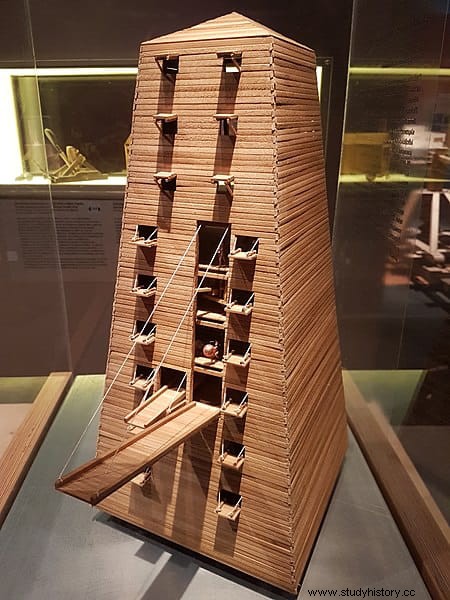At the death of Alexander the Great, his fabulous domains were distributed among the generals of the army, among whom there were their pluses and minuses to get the largest portion of the cake. In the end, the winner in this distribution - with the permission of Ptolemy, who stayed with the rich Egypt - was Antigonus I Monophthalmos, who had already served Philip II before and after beating his rivals one by one, he managed to be the diadochus of Macedonia. , seizing most of the empire and the royal treasury. Antigonus, who died in battle against the other diadochi, was succeeded by his son Demetrius, who has gone down in history by the nickname of Poliorcetes , i.e. the City besieger . The reason for the nickname is obvious but it is paradoxical that it crashed into the defenses of the most important, Rhodes, where we must highlight a curious anecdote that had repercussions on military engineering in the following centuries and on art.

According to the times in which he lived, Demetrius learned the trade of arms as a child, accompanying his father in the campaign against Eumenes de Cardia during the aforementioned War of the Diadochi and receiving a command for the first time at the age of twenty-two. to defend Syria against Ptolemy's attack (by the way, with resounding defeat in the battle of Gaza, in which he lost half a thousand men plus another eight thousand who remained prisoners and was left without war elephants). However, from that young age he progressed to become the best soldier of his father, which did not prevent him from seeing his empire diminish little by little and ending up with barely a third of the original.
The state of war was continuous and once the rivalries with Ptolemy and Seleucus (who appropriated the eastern satrapies) were settled, attention remained focused on Athens, against which Demetrius sent a powerful fleet, freeing it from Cassander's dictatorship, earning the Athenian worship. That same fleet allowed him to destroy the Egyptian at Salamis and it is believed that the famous Victory of Samothrace commemorated this triumph. Consequently, Cyprus fell into his hands and Demetrius was associated with the throne by his father, ruling together.
In the year 305 B.C. The events that really concern us in this article took place. Like the Cypriots, Rhodes was an ally of Egypt and its ships controlled the trade routes in the Aegean, so Demetrius led a punitive expedition, initiating one of the most famous sieges of ancient times:two hundred warships, one hundred fifty auxiliaries, thirty thousand soldiers and a thousand merchantmen waiting for the end of the war to do business... But things were not going to be easy because the Rhodians had strong defenses and their powerful navy allowed them to continually break the blockade. 
The Greeks had to build a port to operate as close as possible, in addition to laying siege also on land by erecting a camp from which their troops razed the island so that the city would have no food. Little more could be done because the frontal assault attempts failed and although it was possible to open a breach in the walls at some time, it was impossible to take advantage of it. And that Demetrius made a show of imagination, ordering his engineers to manufacture a variety of war machines (hence the study of sieges is known today as poliorcetica), although often counteracted by another similar one from the defending side .
This is the case of the mines with which an attempt was made to demolish the walls from the foundations, of a gigantic battering ram fifty-five meters long, which required a thousand men to manage and, above all, of a colossal siege tower that received the name of Helepolis , the Conqueror of cities . This type of weapon, generically called bastida , it was not new; It was used throughout Antiquity (and would continue in the Middle Ages until the appearance of artillery made it unnecessary) as a way of placing troops on the battlements, saving their height and protected from enemy arrows. But Helepolis it was special due to its enormous dimensions.
According to the Greek historian Diodorus of Sicily in his work Historical Library (1st century BC), it was based on a design made by Epimachus of Athens during the siege of Salamis that same year:a platform with a square base and nine floors through which They distributed throwing weapons such as heavy catapults (to launch stones), medium (to launch assegais) and light (for small songs), in ascending succession from more to less caliber. It moved slowly on four wheels, powered by a winch that required the strength of two hundred men. However, Demetrius demanded that Epimachus build an even larger one.
Paying attention to the descriptions left by other authors such as Diéclides de Abdera, Ateneo el Mecánico , Vitruvius or Plutarch, Helépolis It would measure approximately forty-five meters high by eighteen wide, weigh one hundred and sixty tons and move on eight wheels of three and a half meters in diameter with iron-lined tires and that could turn to change direction. It was pushed by a thousand men from inside but supported from the outside -using the system described above- by another three thousand four hundred, after clearing the road.
The interior was divided into nine floors, decreasing in size as one ascended and each connected by two flights of stairs (one going up and one going down), while on the outside the wooden structure was protected from incendiary arrows by a covering of metal plates. iron on three of the sides; in the front, equipped with loopholes with folding shutters to be able to shoot and therefore more exposed, the protection was a padding of skins against the projectiles of the enemy lithoballs. And it is that Helépolis was not designed to raise troops to the walls but to house catapults, oxybeles and ballistae. galapagos were added to the sides reinforcement with rams and covered galleries for the sappers.

These characteristics and numbers (slightly variable according to each chronicler) made it probably the largest siege engine ever built. Interestingly, Demetrio's initial intention was to make two and place them on horseback between four ships, although the complexity of this operation and the bad weather made him give up, focusing on the land attack. In that sense, Helépolis he managed to bring down a keep although, as we saw earlier, the Rhodians were able to repulse the subsequent assault.
Despite its fearsome appearance, this impressive device was not as powerful as it seemed. Subsequently, the defenders prevented it from getting close enough by flooding the surrounding terrain and then, in an incursion, caused damage to it by detaching several iron plates with the aim of setting it on fire; Demetrio had to order its withdrawal to repair it. Quite a metaphor for that campaign, which ended in failure, with Rhodes resisting for a year despite the casualties received (five thousand four hundred dead from an army of just over eleven thousand troops compared to the thousand three hundred Greeks) and finishing it all, before the arrival of an Egyptian relief fleet, signing a peace treaty.
The epilogue is still missing, just as interesting. When the besiegers left, Helepolis was abandoned in front of the city. In 292 BC the Rhodians, sold all the material left there by the enemy and, following the wish of Demetrius himself (or, at least, so the legend says) they used the money obtained - three hundred talents, although the costs would skyrocket - to pay the sculptor Cares of Lindos the erection of a great statue in honor of the god Helios. The metal plates of the tower, duly cast, formed part of the metal used to make the internal structure. That statue, which was lost in an earthquake sixty-six years later, would become one of the seven wonders of the world:the Colossus of Rhodes.
